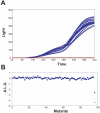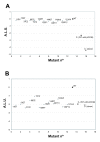Escherichia coli genes affecting recipient ability in plasmid conjugation: are there any?
- PMID: 19203375
- PMCID: PMC2645431
- DOI: 10.1186/1471-2164-10-71
Escherichia coli genes affecting recipient ability in plasmid conjugation: are there any?
Abstract
Background: How does the recipient cell contribute to bacterial conjugation? To answer this question we systematically analyzed the individual contribution of each Escherichia coli gene in matings using plasmid R388 as a conjugative plasmid. We used an automated conjugation assay and two sets of E. coli mutant collections: the Keio collection (3,908 E. coli single-gene deletion mutants) and a collection of 20,000 random mini-Tn10::Km insertion mutants in E. coli strain DH5alpha. The combined use of both collections assured that we screened > 99% of the E. coli non-essential genes in our survey.
Results: Results indicate that no non-essential recipient E. coli genes exist that play an essential role in conjugation. Mutations in the lipopolysaccharide (LPS) synthesis pathway had a modest effect on R388 plasmid transfer (6 - 32% of wild type). The same mutations showed a drastic inhibition effect on F-plasmid transfer, but only in liquid matings, suggesting that previously isolated conjugation-defective mutants do in fact impair mating pair formation in liquid mating, but not conjugative DNA processing or transport per se.
Conclusion: We conclude from our genome-wide screen that recipient bacterial cells cannot avoid being used as recipients in bacterial conjugation. This is relevant as an indication of the problems in curbing the dissemination of antibiotic resistance and suggests that conjugation acts as a pure drilling machine, with little regard to the constitution of the recipient cell.
Figures






Similar articles
-
Genome-wide screen for Escherichia coli genes involved in repressing cell-to-cell transfer of non-conjugative plasmids.Biochem Biophys Res Commun. 2012 Nov 30;428(4):445-50. doi: 10.1016/j.bbrc.2012.10.098. Epub 2012 Nov 3. Biochem Biophys Res Commun. 2012. PMID: 23131563
-
Bacterial conjugation mediated by plasmid RP4: RSF1010 mobilization, donor-specific phage propagation, and pilus production require the same Tra2 core components of a proposed DNA transport complex.J Bacteriol. 1995 Aug;177(16):4779-91. doi: 10.1128/jb.177.16.4779-4791.1995. J Bacteriol. 1995. PMID: 7642506 Free PMC article.
-
Genome-wide screening of Escherichia coli genes involved in execution and promotion of cell-to-cell transfer of non-conjugative plasmids: rodZ (yfgA) is essential for plasmid acceptance in recipient cells.Biochem Biophys Res Commun. 2012 Apr 27;421(1):119-23. doi: 10.1016/j.bbrc.2012.03.127. Epub 2012 Apr 3. Biochem Biophys Res Commun. 2012. PMID: 22497891
-
Natural and Artificial Strategies To Control the Conjugative Transmission of Plasmids.Microbiol Spectr. 2018 Jan;6(1):10.1128/microbiolspec.mtbp-0015-2016. doi: 10.1128/microbiolspec.MTBP-0015-2016. Microbiol Spectr. 2018. PMID: 29327679 Free PMC article. Review.
-
Analysis of the sequence and gene products of the transfer region of the F sex factor.Microbiol Rev. 1994 Jun;58(2):162-210. doi: 10.1128/mr.58.2.162-210.1994. Microbiol Rev. 1994. PMID: 7915817 Free PMC article. Review.
Cited by
-
Recipient UvrD helicase is involved in single- to double-stranded DNA conversion during conjugative plasmid transfer.Nucleic Acids Res. 2023 Apr 11;51(6):2790-2799. doi: 10.1093/nar/gkad075. Nucleic Acids Res. 2023. PMID: 36772829 Free PMC article.
-
Mobilization of the nonconjugative virulence plasmid from hypervirulent Klebsiella pneumoniae.Genome Med. 2021 Jul 22;13(1):119. doi: 10.1186/s13073-021-00936-5. Genome Med. 2021. PMID: 34294113 Free PMC article.
-
Targeting Antibiotic Resistance Genes Is a Better Approach to Block Acquisition of Antibiotic Resistance Than Blocking Conjugal Transfer by Recipient Cells: A Genome-Wide Screening in Escherichia coli.Front Microbiol. 2020 Jan 8;10:2939. doi: 10.3389/fmicb.2019.02939. eCollection 2019. Front Microbiol. 2020. PMID: 31969865 Free PMC article.
-
Genome-wide screening with hydroxyurea reveals a link between nonessential ribosomal proteins and reactive oxygen species production.J Bacteriol. 2013 Mar;195(6):1226-35. doi: 10.1128/JB.02145-12. Epub 2013 Jan 4. J Bacteriol. 2013. PMID: 23292777 Free PMC article.
-
De Novo Synthesis of a Conjugative System from Human Gut Metagenomic Data for Targeted Delivery of Cas9 Antimicrobials.ACS Synth Biol. 2023 Dec 15;12(12):3578-3590. doi: 10.1021/acssynbio.3c00319. Epub 2023 Dec 4. ACS Synth Biol. 2023. PMID: 38049144 Free PMC article.
References
Publication types
MeSH terms
Substances
LinkOut - more resources
Full Text Sources
Other Literature Sources
Research Materials

